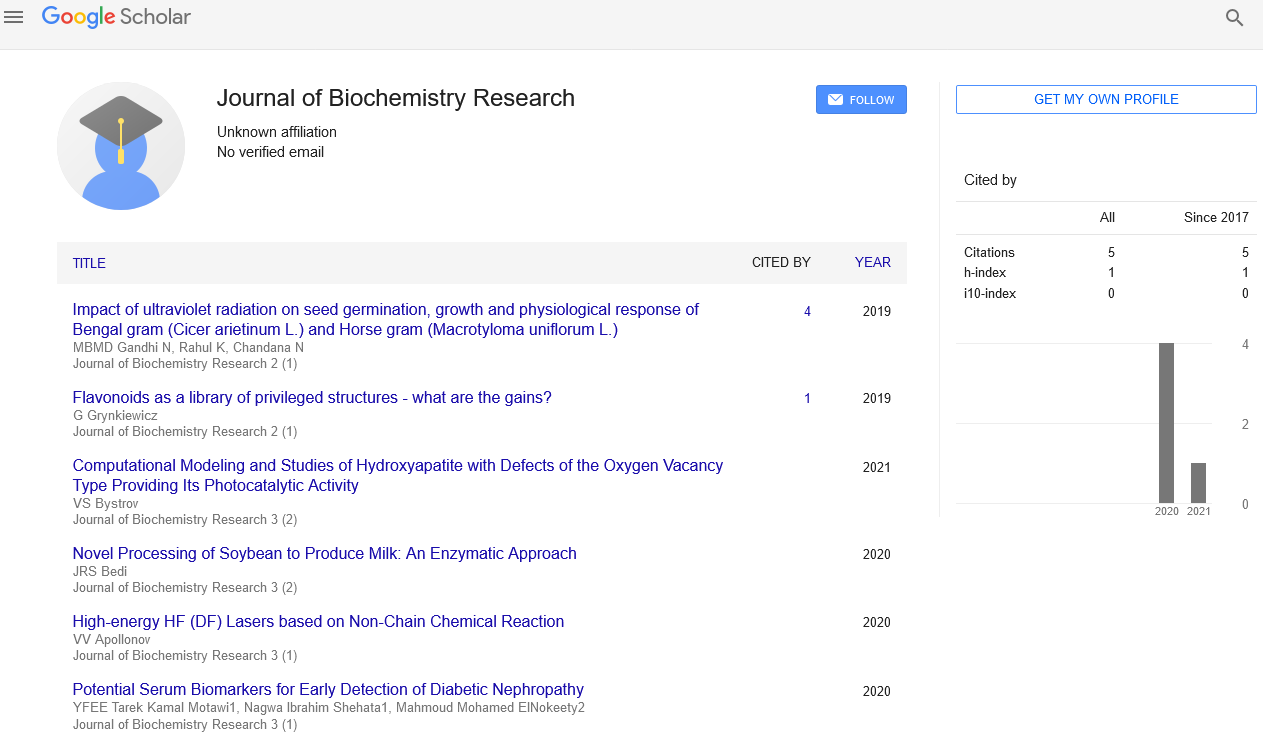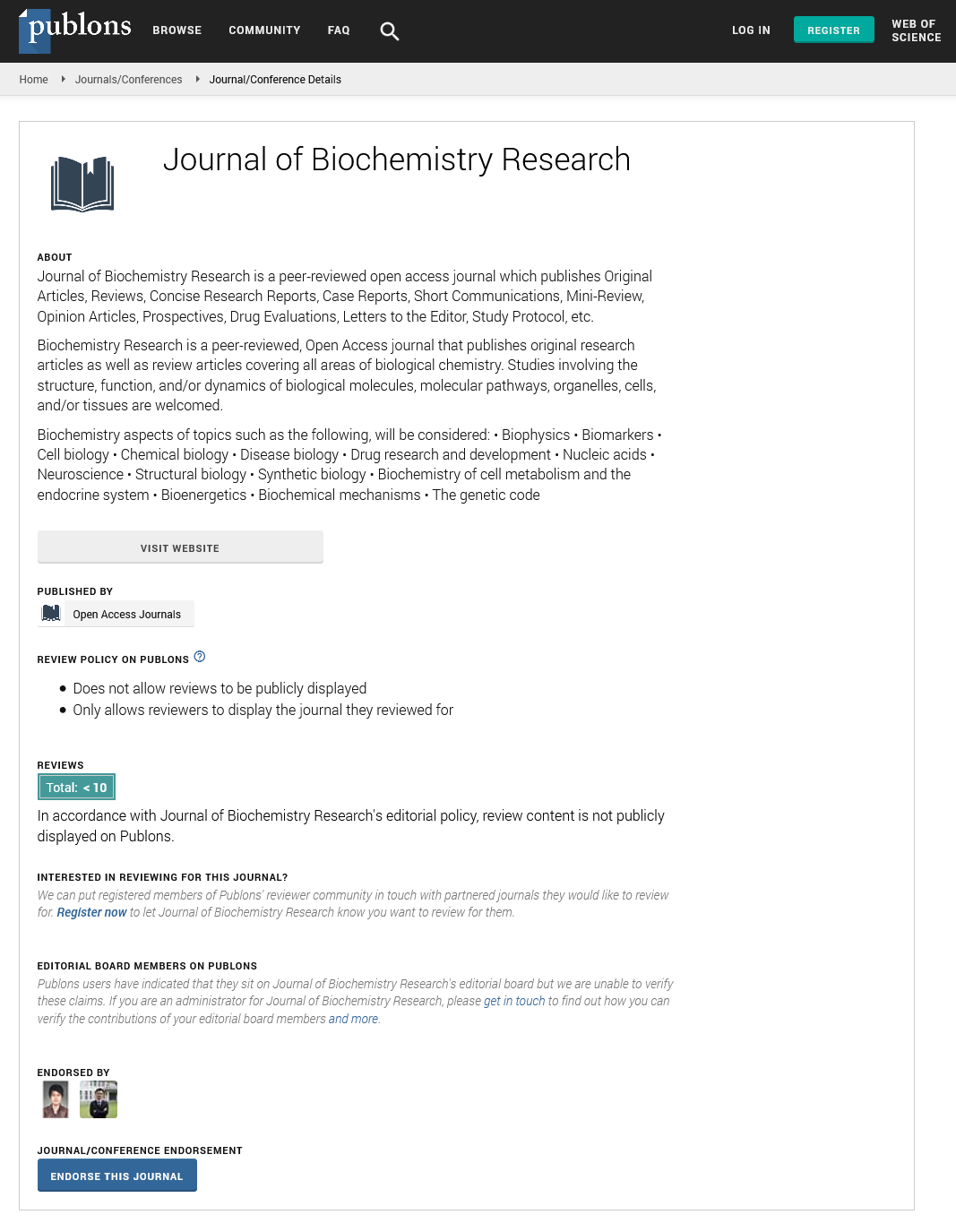Editorial - Journal of Biochemistry Research (2023) Volume 6, Issue 3
Protein Synthesis Unveiled: Unraveling the Intricacies of Cellular Machinery to Decipher the Secrets of Life
Caifang Cao*
College of Computer Science, Department of biological Science of japan University
- *Corresponding Author:
- Caifang Cao
College of Computer Science, Department of biological Science of japan University
E-mail: caifangc@gmail.com.in
Abstract
Protein synthesis is a remarkable biological process that lies at the core of all living organisms, enabling the creation of the diverse array of proteins essential for life. This abstract provides an overview of the intricate machinery and steps involved in protein synthesis, highlighting the pivotal role of DNA, RNA, and ribosomes. The transcription process, occurring within the nucleus, converts DNA’s genetic information into messenger RNA (mRNA), which then travels to the cytoplasm for translation. During translation, ribosomes decode the mRNA sequence, utilizing transfer RNA (tRNA) molecules to assemble amino acids into polypeptide chains. Understanding protein synthesis is vital for comprehending fundamental cellular functions and the regulation of biological processes. Errors in protein synthesis can lead to genetic disorders, emphasizing the importance of unraveling its intricacies. Additionally, advancements in protein synthesis research have promising implications in fields such as medicine and biotechnology. By delving into the secrets of protein synthesis, scientists aim to uncover the mysteries of life itself.
Keywords
Protein synthesis • Cellular machinery • DNA • RNA • Ribosomes • Transcription • Translation • Genetic information• Messenger RNA (mRNA) • Ttransfer RNA (tRNA) • Polypeptide chains
Introduction
Protein synthesis, the intricate process by which cells create proteins, lies at the heart of all living organisms, serving as a fundamental mechanism for sustaining life [1]. From the smallest microorganisms to complex multicellular organisms, protein synthesis plays a pivotal role in numerous biological functions, including growth, repair, and the regulation of cellular processes [2]. By unraveling the intricacies of cellular machinery involved in protein synthesis, scientists aim to decipher the secrets of life itself. At the core of protein synthesis is the interplay between three key players: deoxyribonucleic acid (DNA), ribonucleic acid (RNA), and ribosomes [3]. DNA, residing within the nucleus of eukaryotic cells, serves as the blueprint of life, containing the instructions for building and operating an organism. However, DNA cannot directly participate in protein synthesis. Instead, it transfers its genetic information to RNA, a versatile nucleic acid that acts as an intermediary [4]. Three major types of RNA are involved in protein synthesis. Messenger RNA (mRNA) carries the genetic information from DNA to the site of protein synthesis. Transfer RNA (tRNA) acts as an adaptor molecule, ferrying amino acids to the ribosomes. Ribosomal RNA (rRNA) forms the structural components of ribosomes, the cellular machinery responsible for protein production. The collaboration between DNA, RNA, and ribosomes orchestrates the remarkable process of protein synthesis. Protein synthesis unfolds in two main stages: transcription and translation [5]. Transcription occurs within the nucleus, where an enzyme called RNA polymerase binds to specific regions of DNA known as promoters [6]. The DNA unwinds, and RNA polymerase synthesizes a complementary mRNA strand based on the DNA template [7]. This process involves the addition of nucleotides to the growing mRNA chain until a termination signal is reached. After transcription, the newly formed mRNA molecule moves from the nucleus to the cytoplasm, where translation takes place. Translation is the process by which the genetic information encoded in mRNA is converted into a specific sequence of amino acids, ultimately forming a protein. Ribosomes, consisting of large and small subunits, read the mRNA in triplets known as codons, with each codon corresponding to a specific amino acid. During translation, tRNA molecules carrying the corresponding amino acids recognize and bind to their respective codons on the mRNA [8]. The ribosome facilitates the joining of these amino acids through peptide bonds, forming a polypeptide chain. This process continues until a stop codon is encountered, signaling the completion of protein synthesis [9]. The significance of protein synthesis extends far beyond its role in building proteins. Proteins are vital for carrying out essential tasks within cells, such as catalyzing biochemical reactions, providing structural support, transporting molecules, and serving as signals for cellular communication. Disruptions or errors in protein synthesis can lead to severe consequences, giving rise to genetic disorders and impacting overall organismal development [10].
Materials and Methods
The process of unraveling the intricacies of protein synthesis involves a combination of experimental techniques and advanced technologies. This section provides an overview of the materials and methods commonly employed in studying protein synthesis and understanding the cellular machinery involved.
The players: DNA, RNA, and Ribosomes
Protein synthesis is initiated by the master molecule of life, deoxyribonucleic acid (DNA). DNA resides within the nucleus of eukaryotic cells and serves as the genetic blueprint that contains the instructions for building and operating an organism. However, DNA cannot directly participate in protein synthesis. Instead, it transfers its genetic information to another type of nucleic acid called ribonucleic acid (RNA). Three major types of RNA are involved in protein synthesis: messenger RNA (mRNA), transfer RNA (tRNA), and ribosomal RNA (rRNA). mRNA carries the genetic information from DNA to the site of protein synthesis, while tRNA acts as an adaptor molecule, bringing amino acids to the ribosomes. rRNA, on the other hand, forms the structural components of ribosomes, which are the protein factories of the cell.
The steps of protein synthesis
Protein synthesis occurs in two main stages: transcription and translation.
Transcription: Transcription takes place within the nucleus, where an enzyme called RNA polymerase binds to a specific region of DNA known as the promoter. The DNA unwinds, and the RNA polymerase synthesizes a complementary mRNA strand based on the DNA template. This process, known as transcription, involves the addition of nucleotides to the growing mRNA chain until a termination signal is reached.
Translation: After transcription, the mRNA molecule moves from the nucleus to the cytoplasm, where translation occurs. Translation is the process by which the genetic information encoded in the mRNA is converted into a specific sequence of amino acids, ultimately forming a protein. It takes place in ribosomes, which consist of large and small subunits. The ribosome reads the mRNA in triplets called codons, and each codon corresponds to a specific amino acid. During translation, tRNA molecules carrying the corresponding amino acids recognize and bind to their respective codons on the mRNA. The ribosome facilitates the joining of these amino acids through peptide bonds, forming a polypeptide chain. This process continues until a stop codon is encountered, signaling the completion of protein synthesis.
The significance of protein synthesis
Protein synthesis is crucial for various aspects of cellular function and overall organismal development. Proteins are responsible for carrying out essential tasks within cells, such as catalyzing biochemical reactions, providing structural support, transporting molecules, and serving as signals for cellular communication. Without protein synthesis, life as we know it would not exist. Errors in protein synthesis can have severe consequences. Mutations in the DNA sequence can lead to errors in mRNA synthesis, resulting in misfolded or nonfunctional proteins. These mutations can give rise to genetic disorders, such as cystic fibrosis, muscular dystrophy, or sickle cell anemia. Moreover, understanding protein synthesis has significant implications in medicine and biotechnology. Pharmaceutical research aims to develop drugs that target specific proteins involved in diseases, and advancements in protein engineering and synthetic biology have led to the production of novel proteins with enhanced properties for various applications.
Conclusion
Protein synthesis, a complex and precisely regulated process, serves as the cornerstone of life, enabling the creation of proteins that are essential for the functioning of cells and organisms. Through the interplay of DNA, RNA, and ribosomes, the intricate machinery of protein synthesis orchestrates the transformation of genetic information into functional proteins. By unraveling the intricacies of protein synthesis, scientists have gained profound insights into cellular functions and the regulation of biological processes. The transcription and translation steps, facilitated by RNA polymerase, ribosomes, and tRNA molecules, ensure the accurate assembly of amino acids into polypeptide chains, leading to the formation of functional proteins. Understanding protein synthesis has significant implications in various fields, including medicine and biotechnology. Insights into protein synthesis have paved the way for targeted drug development, aiming to modulate specific proteins involved in diseases. Advances in protein engineering and synthetic biology have allowed the creation of novel proteins with enhanced properties, opening doors for therapeutic applications, biocatalysis, and biotechnological innovations. Moreover, errors or disruptions in protein synthesis can lead to genetic disorders and impact overall organismal development. Studying protein synthesis provides valuable knowledge for diagnosing and understanding the mechanisms underlying these disorders, leading to potential therapeutic interventions. The combination of experimental techniques, advanced technologies, and computational modeling has contributed to unraveling the secrets of protein synthesis. From cell culture and nucleic acid isolation to PCR, DNA sequencing, and protein analysis, researchers employ a multidisciplinary approach to investigate and elucidate the intricate mechanisms of protein synthesis.
References
- Thorn, Caroline F. Doxorubicin Pathways: Pharmacodynamics and Adverse Effects. Pharmacogenet Genomics. 21, 440-446 (2011).
- Jellish WS. General Anesthesia versus conscious sedation for the endovascular treatment of acute ischemic stroke. J Stroke Cerebrovasc Dis. 25, 338-341 (2015).
- Jackson, Peter. The multiple ontologies of freshness in the UK and Portuguese agri food sectors. Trans Inst Br Geogr. 44, 79-93 (2019).
- Mamdouh N, Khattab A. YOLO-based deep learning framework for olive fruit fly detection and counting. IEEE Access. 9, 84252-8426 (2021).
- Maglaveras N, Stamkopoulos T, Diamantaras K et al. ECG pattern recognition and classification using non-linear transformations and neural networks: a review. Int J Med Inform. 52,191–208 (1998).
- Kobayashi H. Airway biofilms: implications for pathogenesis and therapy of respiratory tract infections. Respiratory medicine. 4, 241-253 (2005).
- Roberts CK, Won D, Pruthi S et al. Effect of a short-term diet and exercise intervention on oxidative stress, inflammation, MMP-9, and monocyte chemotactic activity in men with metabolic syndrome factors. J Appl Physiol. 100, 1657-65 (2006).
- Sertkaya A, Wong HH, Jessup A et al. Key cost drivers of pharmaceutical clinical trials in the United States. Clinical Trials. 13, 117-26(2016).
- Popper ZA, Michel G, Hervé C et al. Evolution and diversity of plant cell walls: from algae to flowering plants. Annu Rev Plant Biol. 62, 567-590 (2011).
- Dora, Veronica Della. Infrasecular geographies: Making, unmaking and remaking sacred space. Prog Hum Geogr. 42, 44-71 (2018).
Indexed at, Google Scholar, Crossref
Indexed at, Google Scholar, Crossref
Indexed at, Google Scholar, Crossref
Indexed at, Google Scholar, Crossref
Indexed at, Google Scholar, Crossref
Indexed at, Google Scholar, Crossref
Indexed at, Google Scholar, Crossref
Indexed at, Google Scholar, Crossref
Indexed at, Google Scholar, Crossref


